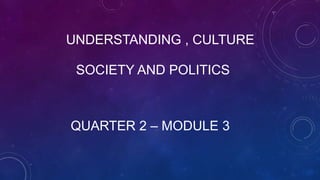
Understanding culture, society, and politics.pptx
- 1. QUARTER 2 – MODULE 3 UNDERSTANDING , CULTURE SOCIETY AND POLITICS
- 3. SOCIAL AND POLITICAL STRATIFICATION • 1. Reciprocity this transaction between two socially equal parties involves goods or services that are estimated to be of equivalent values. More than economic, these transactions signify social ties being created or strengthened by the gesture of gift-giving. (Haviland, Prins, Walrath, and McBride, 2008) PATTERNS OF DISTRIBUTION AND EXCHANGE OF MATERIAL GOODS
- 4. THERE ARE THREE TYPES OF RECIPROCITY, AS FOLLOWS: • Generalized Reciprocity – done by closely related people; this is more of a gesture to express personal relationships than an economic transaction (Kottak, 2000) • Balanced Reciprocity – transaction occurs between two distantly related people; the giver expects something in return, although it does not have to be done immediately.
- 5. • Negative Reciprocity – this transaction is done with people considered to be outsiders of the group; having no personal relationship with the other party, the transaction is based on distrust. This leads people to try to get as much out of the transaction and giving the least amount possible even if done through deceitful means. (Kottak, 2000).
- 6. • 2. Redistribution all produce form the community is sent to the center where they are stored, counted and later on distributed back to the people. It is usually the chief who is in-charge of this process. Any surplus, he may keep for various purposes (e.g. give to his children, or prepare a feast for a visitor who is a potential partner in military operations). (Haviland, Prins, Walrath, and McBride, 2008).
- 7. • 3. Market Exchange the price of exchange of goods and services are supposedly dictated by the rules of supply and demand; however, personal loyalties and moral values intervene in price determination most of the time. (Haviland, Prins, Wairath, and McBride, 2008)
- 8. WHAT IS SOCIAL STRATIFICATION? • In the early days, since the development of early civilizations, social and political stratification shaped and influenced the day to day operation of the society. Hence, the make or break of the society is also dictated to some extent by these categorizations both in political and social aspects. (Santarita, Madrid 2016)
- 9. • Social stratification refers to the arrangement of groups of people along a continuum of different categories that indicate differences in unequal life rewards and chances. (Haviland, Prins, Walrath, and McBride, 2008, Newman, 2012) • It refers to the division of society into levels, steps or positions. It contains strata that shares unequally on the distribution of societal rewards. Social stratification tends to be transmitted from one generation to another. The people are ranked based on hierarchy that are significant in delimiting their access to the range of resources and/or opportunities available to them. (Malate, 2016)
- 10. • A. Wealth - encompasses all a person’s material assets, including income, land, and other types of property. (Schaefer and Lamm, 1992 in Kottak, 2000:377) • According to Max Weber, the person’s status, or position within a stratified social system, is determined by the following:
- 11. • B. Power - the capacity to influence or control the behaviour of persons and institutions, whether by persuasion, or coercion. (Magstadt, 2013:3) • C. Prestige - esteem, respect, or approval for culturally valued acts or qualities. (Kottak, 2000:360)
- 12. FUNCTIONALIST VIEW CONFLICT VIEW 1. Stratification is universal, necessary and inevitable. 1. Stratification may be universal without being necessary and inevitable. 2. Social organization (the social system) shapes the stratification system. 2. The stratification system shapes social organization (social system). 3. Stratification arises from the societal need for integration, coordination, and cohesion. 3. Stratification arises from group conquest, competition and conflict. 4. Stratification facilitates the optimal functioning of society and the individual. 4. Stratification impedes the optimal functioning of society and the individual.
- 13. 5. Stratification is an expression of the commonly shared social values. 5. Stratification is an expression of values of powerful groups. 6. Power is usually legitimately distributed in society. 6. Power is usually illegitimately distributed in society. 7. Tasks and rewards are equitably allocated. 7. Tasks and rewards are inequitably allocated. 8. The economic dimension is paramount in society. 8. The economic dimension is subordinate to other dimensions of society. 9. Stratification systems often change through evolutionary process. 9. Stratification systems generally change through revolutionary process.
- 14. WHAT IS SOCIAL MOBILITY? • Social mobility is one’s ability to move from one place to another along the stratified positions of society. (Haviland, Prins, Wairath, and McBride, 2008) The ease or difficulty by which this shift or move from one place to another is highly dependent on the type of society one lives in (Kottak, 2000) open or closed.
- 15. • A. Open. The society is considered open when the stratification is based on social classes, where people’s position are determined by the economic wealth and income. An open system is such as this is able to facilitate social mobility based on personal efforts and individual achievements. (Kottak, 2000)
- 16. • B. Closed. The system is considered closed when the change or shift in social positions or social mobility are limited and perhaps prohibited in some societies. An example of the closed system is the caste system, where people are born into their social position (inherited from their parents) and remain there for the rest of their lives. It is very difficult to shift from one social position to another as laws, both legal and religious, prohibit any movement between the very clearly established boundaries of caste. (Newman, 2012)